In a land crisscrossed by interstates, punctuated with traffic lights, and clogged with cars, it’s easy to overlook how much northwestern New Jersey territory you can still cover on a horse.
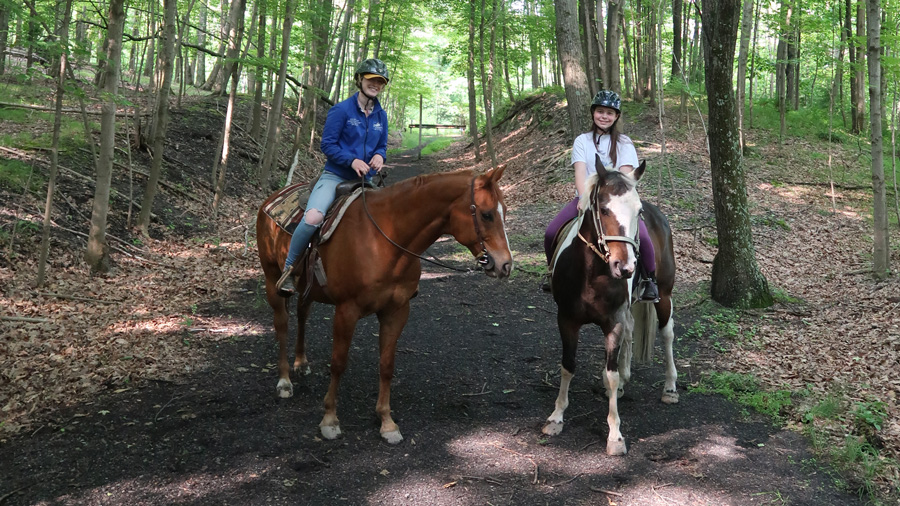
Through warm summer months and into fall, you can explore rivers, streams, fields, and hills and enjoy remote views and vistas—all from the saddle. Across the Skylands region, a horse can take you where no car can—faster and sometimes farther afield than your own two feet. Exercise? Certainly. But also the pleasure of working with a 1,000-pound companion who can handle the footwork.
Whether you meander with a guide or on a steed trained to follow the horse ahead of him “head to tail,” or, with more experience, race and jump for miles cross country, being on horseback takes you back in time. Public and private stables and clubs offer riding opportunities and experiences for all levels, from beginner to expert.
It took nearly 200 years for the horse, which appeared on the state seal when it was presented to the legislature in 1777, to be named the official state animal. That happened when Gov. Brendan Byrne, campaigning for office, stopped at the Sussex County Farm and Horse Show on August 14, 1977 and announced the news. Forty years later, the horse still holds its title; and with it an enduring role in the area’s economy, recreation, imagination, even architecture.
New Jersey has more horses per person and square mile than any other state in the country, according to the New Jersey Horse Council. The state offers just about every kind of horse experience imaginable, from rambunctious western rodeo to fox hunting steeped in British tradition. And you can sample them all without ever leaving its northwest corner. Dip in or dive in, whatever your inclination and ability.
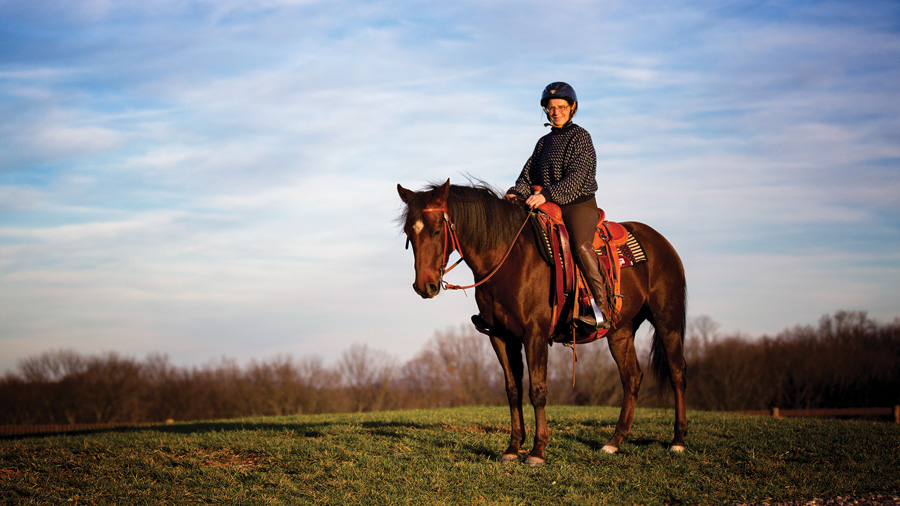
Easy riding? My friend Susan and I saddled up on an unusually warm spring day at the Lord Stirling Stables, a Somerset County Park Commission facility in Basking Ridge. We were looking for a relaxed trail ride, and our guide assured us we’d be walking at a comfortable pace, sampling some of Lord Stirling’s nearly fifteen miles of trails (all levels of riding can be accommodated for lessons, but before you head out on a trail ride, the stable will want to check out your riding experience and skills). Susan is an expert rider, comfortable in an English, hornless saddle, a true equestrian and riding teacher. I’m just what they call a “pleasure” rider, generally comfortable riding in an English or Western saddle, but at a basic level. We brought our own helmets and boots (mine very tired paddock boots I bought to use for lessons years ago). For those who don’t own a helmet, Lord Stirling has plenty on hand that it rents for modest fee. Our guide met us outside the main barn and introduced us to our good natured horses: “Goldie” and “Uno.” The stable uses mounting blocks, portable stairs placed next to the horse, so you just step right up to horse level and get on board. This saves you the discomfort of getting one foot in the stirrup from ground level and then hitching and heaving yourself up and over the horse and into the saddle. They say it also saves the horse’s back.
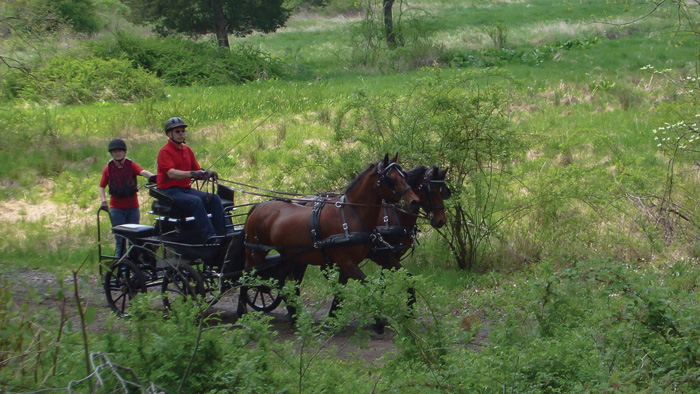
Goldie and Uno took us away through freshly green woods, wetlands, and grass fields populated by deer and hawks, across land that once belonged to one of George Washington’s most trusted military men. Revolutionary War Brigadier General Stirling presided over this gentle, peaceful landscape, mostly flat with modest dips and rises. Susan trotted Goldie once to catch up since his gait was slower but other than that our ride was at a walk. Escaping for just one hour at lunchtime, we returned to our routine refreshed by an equine respite with no scares or surprises.
Odds are the same can’t be said after a fox hunting excursion, but adventurous and skilled riders can run horses in an exhilarating chase across miles of private and public land, to the sound of baying of the hounds. It’s BYOH (Bring Your Own Horse), or borrow one from a willing member or friend.
“This is not just a visual thing; you also hear it,” explains Edwin O. Wiley, Master of Foxhounds for Windy Hollow Hunt, a private club open to those who can handle a “comfortable gallop” and jump a three foot fence or wall. Before joining, you’ll be asked to participate in three “caps”—paid trial rides. (The term comes from the tradition of putting the money for your ride in the host’s cap.) The hunt master controls the highly trained hounds with voice commands.
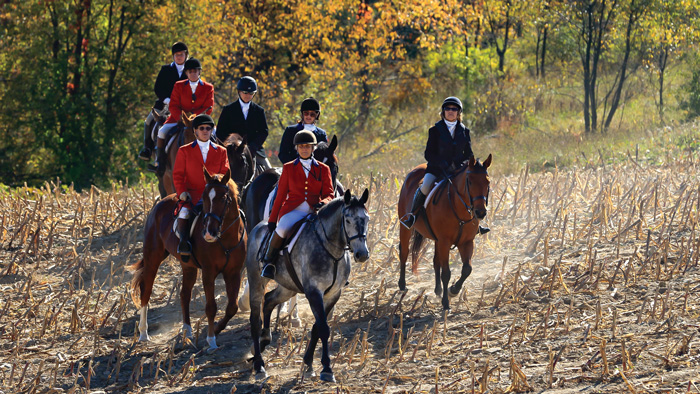
But there’s way more to the fox hunt experience than hounds and riding—it’s social. “In the fox hunting world, ‘ says Wiley, “you can enjoy the hunting, the hounds, and the parties.” Or after-parties, to be exact, hosted by members after every hunt. (For the record, unlike in England, where foxes have long been considered a pest, Skylands fox hunting excursions rarely end with a prey fatality, Wiley says, adding, “We’re not trying to kill the fox.”) The club’s territory extends over twenty miles through Wantage and ten in Vernon as well as into property on the other side of the New York border, all places where farmers and landowners give members access.
Across the region, a surprising number of private and public lands welcome people on horseback, and miles of public horse trails run through state and county parks. The exception however is a big one: the Appalachian Trail, which cuts across the top of the state and doesn’t allow horses. But that doesn’t mean riders can’t enjoy a similar terrain and views from horse friendly trails. The Irish Trail in High Point State Park welcomes horses, snaking beside the Appalachian Trail for nearly ten miles to the northwest. To the southeast, riders are welcome on the Paulinskill Valley Trail, which traces the path of the Paulinskill, from Newton down to the Delaware River at Columbia. And in Boonton, horses and riders with the energy for a brisk run can canter up the steadily rising Decamp Trail to the “Top of the Tourne” to find long views of rolling hills to the west and a Manhattan skyline vista to the east. The New Jersey Horse Council offers a notebook style guide to the state’s horse trails with tips on access and features.
While horse trails are widespread, Lusscroft Farm in High Point State Park is the only horse facility in the state park system, and there equine trail restoration is an ongoing priority. James Turner, a Montclair businessman, established Lusscroft in 1914 as a state-of-the-art dairy farm, breeding and raising Herefords and Guernsey cows. He donated the property to the state in 1931, after which it became a Rutgers University agricultural research center. The original homestead, perched overlooking paddocks and barns and accented by vanilla veined stone, also looks out on the Kittatinny Valley, where grassy land supported a thriving dairy industry nearly a hundred years ago.

Riders can trailer their horses to the scenic property, which suffered from years of spotty maintenance, but now offers rustic stalls and paddocks for equine visitors. Rebecca Fitzgerald, superintendent of High Point State Park, oversees today’s Lusscroft, which she finds “unique because of the horse use, stables and potential for overnight camping with horses.” Recreational trail grant monies and volunteers associated with the non-profit Heritage and Agricultural Association help with restoration of the paddock fencing, stalls, and trails.
You don’t need your own horse to explore Skylands trails – plenty of stables have horses and guides who will take you out, literally at nearly all hours of the day or night. Lord Stirling offers lunch rides and moonlight trail rides.
Oddly, beginners or nervous riders might consider starting with one of the biggest of horses, those of Budweiser fame, with the shaggy ankles: Clydesdales. Weighing in at roughly 2,000 pounds, they are “gentle giants, says Win Lake, of Willow Grove Stables, a former Long Valley dairy farm that’s now a Clydesdale breeding and training facility. “We had lighter horses for years,” he says. “Then we found out about the calmness of the (Clydesdale) demeanor. Their disposition lends itself to trail riding.” Bred to for traits that make them good farmers’ partners, “they can’t go crazy,” he explains.
Of course some equine experiences demand nothing more than simply sitting, spectating and admiring horses and riders working together in shows and competitions.
June is officially the “Month of the Horse” in New Jersey, and on June 22 and 23, the Mars/Essex Horse Trials, a Hunterdon County fixture for thirty years, returns after a nearly twenty-year hiatus. Long held at the United States Equestrian Team’s headquarters in Gladstone, it returns to a new venue: 230-acre Moorland Farms, home to the annual Far Hills Steeplechase Race Meeting. Featuring competition at the beginner novice and preliminary levels, the event offers visitors not only the thrill of watching riders and horses meet running and jumping challenges, but also party and shopping possibilities—tailgating (for those who buy pricey tickets), a food stall, a signature cocktail called “The Hoopstick” (after Hoopstick Farm in Bedminster where the show began in 1968) plus an emporium full of equine inspired and other wares.
The same June weekend also brings a special event to Lusscroft Farm: evening appearances by Hermann’s Royal Lipizzan stallions, an Austrian breed saved from a Russian onslaught during World War II and known for their artistic and acrobatic dressage performances.
August is fair month, and fairs feature horses. Every summer the Sussex County Farm and Horse Show rounds up the state’s English and Western riding worlds for ten days. The event began in 1919 when the local Branchville riding club put on a horse show for children. The show eventually teamed up with agricultural exhibitors and events and incorporated in 1936. It moved on to larger grounds in Augusta to accommodate bigger crowds who come for an array competitions and exhibitions, including barrel racing, where horses and riders careen around obstacles and ranch riding clinics, where horses perform working maneuvers mimicking what they’d do on a ranch. It is now part of the New Jersey State Fair.
The Warren County Farmers’ Fair, features a miniature horse show. The tiny steeds are put through their paces—obstacle courses and jumps, on a lead. “They have tiny, little baby jumps,” explains long time 4 H leader and fair organizer Ann Thomas.
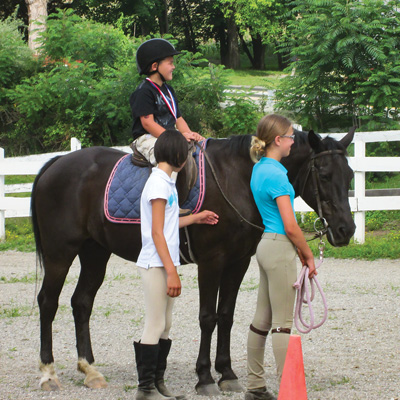
In the realm of horse appreciation, though, possibly nothing comes close to observing these animals’ therapeutic magic. At Lord Stirling, a therapeutic riding program with certified instructors introduces autistic and cognitively impaired children to horses. The results can be amazing, says staff member Nancy Meola. Especially, she says, when “this little boy or girl smiled or spoke for the first time.”
Certified PATH instructors are also a big part of the programs at Morning Star Farm in Fredon, where many of their patrons find riding an effective tonic in dealing with personal loss, depression, or anxiety. “My niece has been riding there for four years,” explains one Morning Star fan. “Every Sunday she and any one or more family member looks forward to just being at the farm. Morning Star Farm just folds you up in its arms and makes you feel happy! The self-confidence, esteem and accomplishment my niece has gotten from riding and taking care of ‘her’ horse, cannot be matched.”
It’s an important lesson for anyone, and perhaps why people are so passionate about horses: riding is a partnership.